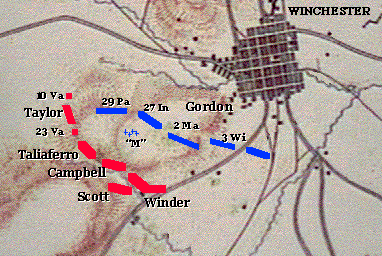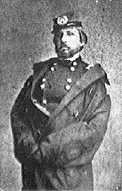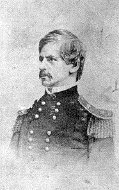

HDQRS. TWENTY-SEVENTH REGIMENT INDIANA VOLS.,
Near Williamsport, Md., May 26, 1862.
SIR: I have the honor of making the following report of the part taken in the action of the 25th instant at Winchester, Va.:
At an early hour in the morning, about 5.30 a.m., I received orders from Asst. Adjt. Gen. C. P. Horton to form my regiment into line of battle on the extreme left of the brigade, which order was promptly obeyed, the left of my regiment resting on the turnpike. My regiment while occupying this position became the target of the enemy's sharpshooters from the rifle pits on the top of the hill and from the top of a tree standing on the brow of the hill. They kept up a constant fire, with but little effect except wounding a private in Company H in the leg.
This position was held by the Twenty-seventh Regiment until I received an order from you, stating that the enemy was flanking us upon the right, and ordering my regiment to the right of the Second Massachusetts, which order was promptly obeyed. My regiment was marched by the right flank past the Twenty-ninth Pennsylvania, Third Wisconsin, and Second Massachusetts. It had scarcely gained its position to the right of the Second Massachusetts before we received a very heavy fire from the enemy's left, consisting of two full regiments of infantry, posted in a skirt of small scrubby timber about 150 yards in my front. We received the first fire of the enemy while the regiment was still marching by the flank. I immediately halted my regiment, brought it to the front into line of battle, and marched it to the front about 20 paces, to gain the advantage of the ground. These orders were executed by the regiment with promptness and coolness, as if it had been upon parade. I gave the order to fire, which was promptly obeyed, and with telling effect upon the enemy's lines.

About this juncture, the Twenty ninth Pennsylvania filed past my regiment and took position on my right. My position brought the right wing of my regiment opposite and in front of the right wing of the enemy's left regiment and the left wing of the Second Regiment.
At about this juncture, and before the Twenty-ninth Pennsylvania had fired a gun, the enemy's left regiment from the line of battle formed into column and marched left in front until it had flanked the Twenty ninth on the right, and then marched by the right flank in column by company, with the evident intention of gaining its rear. From the conformation of the ground I was satisfied that this movement of the enemy, although in plain view of the position occupied by myself, was entirely screened from the observation of Colonel Murphy. I immediately informed him that the enemy had flanked him on the right and was endeavoring to gain his rear. He immediately fell back about 20 paces, gaining a position in view of the enemy and preventing him from gaining his rear.
By a flank movement and filing to the right I brought Companies A and F of my regiment into position, and in connection with the Twenty-ninth Pennsylvania opened fire upon the enemy's left, which checked his flank movement.
At this juncture I discovered that my entire regiment, except Companies A and F, were falling back. As soon as possible I brought them to a halt and about-face and commenced firing. Lieutenant-Colonel Morrison came up to me, and said that he had ordered the regiment to cease firing and fall back. He informed me that he had received the order from you through Aide-de-Camp Lieutenant Scott, and had given the order to the regiment without communicating it to me.
At this time I saw the other regiments falling back, and gave the order to fall back to my regiment. I regret to say that the coolness that had marked every action of the regiment in advancing in the face of the enemy and receiving and returning his fire until the time of the retreat was ordered was by degrees lost, and in spite of every effort of mine ended in disorder to some extent. This fact is attributable to the want of line officers. From various causes I had less than half of my line officers in the action. Company C was without a commissioned officer, and was commanded in the action by Lieut. George Fesler, of Company G.
I wish to state that I am satisfied that the order received by Colonel Morrison did not emanate from your honor, but am satisfied he received the order and acted upon it in good faith, believing it to be from you.
The strength of my regiment in the action was---enlisted men, 431; commissioned officers, 15. Total, 446.
The following is a list of killed, wounded, and missing, so far as I have been able to ascertain:
3 enlisted men Killed
3 Officers and 14 enlisted men Wounded
3 Officers and 101 enlisted men Missing (Compiler's Note: many of these were from the men captured at Buckton Station on the 23d of May)
TOTAL = 124
I have no doubt but that the killed and wounded will be materially increased when the full facts shall be ascertained. Many in the list of the missing are reported to me as having fallen upon the field during the retreat; but I have reported none in the list of killed and wounded except those of whom I have positive information.
Respectfully submitted.
S. COLGROVE,
Colonel, Commanding.
Col. GEORGE H. GORDON,
Commanding Third Brigade, Fifth Army Corps.
Before the engagement ensued, Union Brigade Commander Colonel George Gordon accurately read the confederate movements on his right. Donnelly's Brigade was on his left and he held the right with four regiments; 3d Wisconsin, 2d Massachusettes, 27th Indiana, and 29th Pennsylvania. Initially, Gordon had the 27th and 29th along the valley turnpike to the brigade left. Seeing the enemy movements, he posted the 27th and the 29th to the right of the 2d Massachusettes. This would put the new line of battle as 3d, 2d, 27th and 29th. Here his West Point education was of some worth.
For reasons unknown, Gordon prohibited his regimental commanders from mounting (an order of course that did not apply to himself). Consequently, the rolling terrain meant that a regiment might not be entirely visible to a commander. This was the case of Colgrove and the 27th. No sooner had they been set than the enemy movements to the front began to pick up. The 29th was not fully in position. Attempting to adjust the lines, the 29th and 27th did get coordinated before the general attack, but then a strange event happened.
As Colonel Colgrove and Colonel Murphy of the 29th Pennsylvania were coordinating the defense under fire, Gordon's aide-de-camp, Lieutenant Scott, rode up to the 27th. Not being able to find Colgrove because of the lay of the ground, Scott ordered Lieut. Colonel Morrison to move the regiment back to the other side of the ridge. Just what this meant was not clear but as he rode off, Morrison, being left in command during Colgrove's coordination, began to order a cease fire and about face of the regiment, an order not readily accepted without 6 or 7 repetitions and verbal exhortations from the officers.
Colgrove now returned to see his regiment falling back in good order in the opposite direction. He ordered the regiment halted and to return fire on the enemy, which they did. Morrison explained the order from Scott, so Colgrove then ordered the regiment to comply after seeing the other regiments also falling back. The fact that the artillery was limbering up speaks clearly that they were being rushed by the enemy in numbers too great to make a stand.
Lieutenant Wilkins, of General Alpheus Williams' staff, stated in his report that only three companies stood at a low stone fence (which was not low unless shoulder high is low). This is probably due to Wilkins' estimation of about 300 men there. The veterans speak that the entire regiment took a stand here under the control of their own officers except for two companies, D & I, that were on detached duty. This would be about the 300 men present for the fight. It is not clear why Brigadier General Alpheus Williams mentioned only the 27th Indiana when talking of troops fleeing in his letter to his daughter. Perhaps Williams identified a number of 27th men in this mass and assumed they all belonged to the regiment.
Because of the 27th's stand, the battery supporting the right was now able to withdraw in safety (it is interesting that Gordon placed all the batteries but this one in the vicinity of his old regiment, accounting for the enemy trying the right flank). Confederate General Richard Taylor and 27th veterans speak to the fact of the accuracy of the Hoosiers' fire as causing "many gaps." The lead rebel regiment facing them had 78 killed, not to mention wounded. But Taylor's Louisianians were not checked and reformed well as the attack continued. Now withdrawing through Winchester, the regiment became separated and reformed a mile or so north of Winchester. Thus ended the battle. Almost.

|

|
|
|
|
In the after action report, and in reports to the press, Gordon, bucking for a star and not willing to be blamed by fellow Bostonian Banks, wanted to make sure that if this fight were viewed unfavorably, he could be covered. He offered the 27th as the scape goat, even though they were the last regiment to leave the field. His prolific but enigmatic remarks in the Official Records fail to clarify the matter. These could be interpreted many ways. But what could not be misinterpreted was the accusation in the newspapers that the 27th ran, thus the line broke and the battle was lost. The 27th was so incensed that they demanded their honor exonerated. Lieutenant Scott denied having ever given such an order to withdraw and Gordon claimed no knowledge. After many vacillations, he attempted to smooth things over by talking to the regiment. He never faced up to the problem.
The problem was with Gordon himself. Having proven himself in the Mexian-American War, he took understandable pride in his volunteer regiment that had a large number of West Point and Harvard educated officers. As the colonel of the 2nd Massachusetts, Gordon was fond of using his own Harvard law/West Point (1846) education to belittle the Hoosier officers, particularly Colonel Colgrove, and his deputy, Lieut. Colonel Morrison. As he rose to command of the brigade, Hoosiers weren't all he belittled. The writings he left behind castigating Banks, Governor Andrew of Massachusetts, and Abraham Lincoln offer some insight into his view of himself. It is interesting that after the battle, Gordon was returned to his regiment. Governor Andrew postponed any hopes of him making general officer. He did later manage to get his star, but fortunately, even though he handled himself well at Cedar Mountain, the regiment only suffered under his arrogance for a few more months. He was transferred to backwater departments for the remainder of the war due to ill health. He faded into obscurity only occasionally to be rescued and actually commended as a commander by the likes of such notable historians as John C. Waugh, author of "The Class of 1846."
What is most unfortunate for the Civil War record is the complete hand wave the Battle of Winchester has received. The accounts largely are given only from the Confederate viewpoint, and that view is based usually on the reports of Confederate General Richard Taylor. While Taylor's report is certainly fair and accurate, without considering the chain of decisions and events that occurred by the many participants, one gains a very unfavorable view of the Union troops that bravely fought there and Banks is usually treated unfairly.
Banks was greatly outnumbered and had been given clear instructions to guard numerous points along his line of communication, forcing him into unfavorable and difficult situations. He was a fair field commander. His actions at Cedar Mountain showed he could correctly read a battle, allowing him to rout the vaunted Stonewall Brigade (the only time it ever happened), and nearly win the battle at very long odds.
Steve Russell
4 enlisted men actually killed or died of wounds (vice 3 reported; does not include missing)
|
Company A |
Company D |
|
Corporal Jacob Michael |
Private Henry Albright |
|
Company C |
Private Adam Schardein |
|
Private Edward Quillen |
|
3 Officers and 17 enlisted men actually Wounded (vice 3 & 14 reported; does not include missing)
|
Company A |
Company H |
|
Captain John W. Wilcoxen |
Private W. W. Fitzgerald |
|
Company C |
Private Adam Bias |
|
Private Emanuel Fulp |
Private Patrick Murphy |
|
Private John K. McCaskey |
Private Griffith Ogden |
|
Private Charles Wishmeyer |
Private James M. Richards |
|
Company F |
Private Joseph Stimson |
|
Captain Peter Kop |
Company K |
|
Private George Edwards |
Captain Richmond M. Wellman |
|
Private William W. Edwards |
Private Paul Geppner |
|
Private Henry C. Gabbert |
Private Friedolin Hager |
|
Private Franklin Lemmons |
Private Joseph Schroeder |
3 Officers and 52 enlisted men Missing (vice 3 & 101 reported; does not include missing from Buckton Station)
|
Regimental Headquarters |
Private David Brown |
Private Thomas Kephart |
|
Surgeon Jarvis J. Johnson |
Private James B. Boyd |
Private Joseph McClain (McClane) |
|
Company A |
Private William C. Boyd (died in prison) |
Private Charles Robison (died in prison) |
|
Private Woodson Bryant |
Private Joseph Carroll |
Private Samuel Tomey |
|
Private Hiram Busby |
Private Patrick Curley (wounded and died) |
Private J.M. Wright (died in prison) |
|
Private James DeWitt |
Private Benjamin T. Gregory (*) |
Private George Wemer |
|
Private Sylvestor Layton |
Private Samuel S. Weaver |
Company H |
|
Private Noah J. Palmer |
Private George W. White |
Second Lieutenant Stephen D. Lyon |
|
Private Patrick Ryan |
Company F |
Sergeant George W. Batchelor |
|
Private Thomas Wells |
Second Lieutenant David Van Buskirk |
Corporal Adam Brower |
|
Company B |
Corporal Michael H. Van Buskirk |
Private Adam Bias |
|
Private Bartlett O'Callahan |
Private Benjamin F. Bourne |
Private John M. Brower (*) |
|
Private Charles W. Stanley |
Private David Cook |
Private Martin F. Hall (*) |
|
Company C |
Private George Edwards |
Private Reuben Holbrook |
|
Corporal William Beeson |
Private Michael Healey |
Private John M. McConnell |
|
Company D |
Private John Larkins |
Private Patrick Murphy (died in prison) |
|
Private Elihu Clampitt (wounded) |
Private Abraham Luyster |
Private James M. Richards (wounded) |
|
Private Peter Isaac (died in prison) |
Company G |
Private John W. Walton (died in prison) |
|
Private John Younger (died in prison) |
Private Alexander Andrews |
Company I |
|
Company E |
Private Elisha Bailey |
Private Amos Kersey |
|
Corporal Charles H. Weaver |
Private Henry Fry (died in prison) |
Company K |
|
Private Andrew J. Arnold |
Private Charles Horner |
Private Henry K. Hendricks (deserted and tried to join Confederacy) |
Note that 9 soldiers died in prison after only a few months and 3 others (*) would die to poor health after released in September 1862. Several others were discharged due to poor health.
�
TOTAL CASUALTIES = 79
For comments or suggestions, please contact Steve Russell